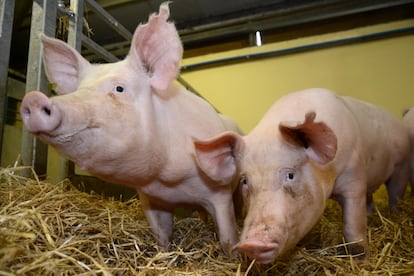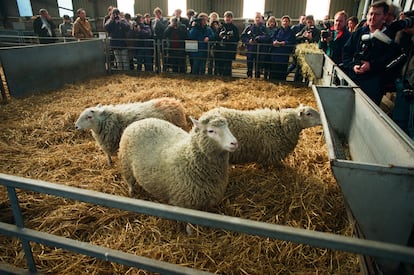From cloning to CRISPR: The center that created Dolly designs epidemic-resistant animals
The Roslin Institute for Animal Research turns to gene editing to combat some of the most important diseases in livestock and poultry

“Am I tired of answering questions about Dolly? Not at all, she was transformative,” explains Bruce Whitelaw, who runs the Roslin Institute near Edinburgh. Whitelaw, wearing a tartan jacket and tie, greets EL PAÍS and explains the new direction of his animal science research center: “We now do fantastic science, we have created pigs resistant to porcine reproductive and respiratory syndrome. The number of farmers going bankrupt because of this disease is enormous. It has a huge impact, agreed, but it will not be as big as Dolly. She was unique.”
Although the institute remains linked to the name of a sheep — the first mammal cloned from an adult cell — they have long since abandoned animal cloning altogether. They are now dedicated to using the enormous power of gene editing — CRISPR technology, which modifies DNA in a cheap, simple and incredibly effective way — to create breeds of farm animals that are more robust, resistant to different types of production stress such as heat or drought, and above all, to diseases.
The diseases studied at Roslin make up a long list of woes for livestock, poultry and, sometimes, human health, and which seem straight out of Oliver Twist: porcine reproductive and respiratory syndrome, classical swine fever, African swine fever, avian flu, West Nile virus, Newcastle disease, those caused by bacteria and complex pathogens such as toxoplasmas or trypanosomes. The new outbreaks of zoonotic diseases, those that manage to jump from animals to humans (such as this summer on dairy farms in the USA affected by bird flu where 14 people have been infected to date), once again demonstrate the close relationship between the health of farm animals and human life.
During the visit to the institute, the cackling of 600 or so hens quickly disappears in the powerful Scottish summer wind. Because it may be summer, but this is Scotland. The National Avian Research Centre is one of the jewels in Roslin’s crown. There, together with geneticists from Imperial College London and the Pirbright Institute, they have created the world’s first hens with some resistance to bird flu. In recent years, this disease has caused the death of hundreds of millions of birds around the world and has spread to mammals such as seals, sea lions, cows and minks, and caused several human deaths in what could be the worst bird flu crisis known in the world.
Using CRISPR to modify a single gene — responsible for producing a protein called ANP32A, which viruses hijack during infection — the scientists have managed to ensure that nine out of 10 of these modified birds show no signs of infection when exposed to a typical dose of the flu virus. When exposed to the high dose, however, five out of 10 — half of the group — become infected.
“Avian influenza is a major threat to poultry populations. Vaccinating against the virus poses many challenges, with significant practical and cost issues,” said Mike McGrew, head of the Avian Reproductive Technologies Chair at Roslin and one of the authors of the paper. “Instead, gene editing offers a promising route to permanent resistance to the disease, which could be passed down through generations, protecting poultry and reducing the risks to humans and wild birds.” McGrew and his team are now attempting to create chickens with modifications to three genes that have been shown in preliminary laboratory tests to block the virus completely.
The Roslin Institute, which employs around 450 researchers, was incorporated into the University of Edinburgh in 2008 after a period of financial hardship, and now occupies a glistening, snakeskin-like building on the Easter Bush veterinary campus, about seven miles south of Edinburgh. It is surrounded by the bare mountains of the Pentland Hills, car dealerships and rows of identical new houses, like clones.

Inside the institute, animals are everywhere, even in the main building’s foyer, which features photos of researchers with chickens and pigs. Outside, there’s a veterinary hospital, an equine hospital; an innovation center, marked by a 17-foot-tall steel sculpture of a horse’s head; and, of course, farms. Vast expanses of eternally green meadows in the Scottish rain, where Dolly was concealed from prying eyes. “The best place to hide a sheep: amongst a bunch of other sheep,” says Whitelaw with a smile. The farm staff spoiled her so much that she had to be put on a diet.
Stopping porcine respiratory syndrome
In addition to these impenetrable-eyed animals, Roslin is also working on chickens, cows, rodents and salmon, but one of the current stars is pigs. Whitelaw and his colleagues have created pigs who are resistant to the virus that causes porcine reproductive and respiratory syndrome (PRRS), a disease that causes a loss of productivity of €1.5 billion ($1.65 billion) a year in Europe alone. To do so, they used CRISPR technology to remove a small fragment of porcine DNA that caused a receptor on the outside of cells, called CD163, to lack a kind of anchor that the virus needs to enter the cell interior and multiply. Without it, the virus bounces off and stays at the door, unable to unleash the infection.
For Whitelaw, “the challenge of these major changes, the manipulation of the genome, is to create animals that are just as robust and productive as before the editing.” And he stresses: “With these pigs, all we have done is stop the virus from entering, everything else is normal. If you make animals resistant to this virus, for example, but they are not going to live as long for whatever reason, it no longer works.”
PPRS-resistant pigs are now roaming around Madison, Wisconsin, on farms owned by Genus PLC, to which Roslin’s team has licensed the product, and they are in the process of being approved by the U.S. Food and Drug Administration (FDA). Whitelaw is optimistic that they could be approved by the end of the year. “If Genus sells semen from these pigs on the market in the near future, it will have a tremendous impact. The number of animals affected by PRRS is in the millions and millions and millions, and many farmers are going out of business because of the disease,” says the Roslin Institute director.
Sign up for our weekly newsletter to get more English-language news coverage from EL PAÍS USA Edition
Tu suscripción se está usando en otro dispositivo
¿Quieres añadir otro usuario a tu suscripción?
Si continúas leyendo en este dispositivo, no se podrá leer en el otro.
FlechaTu suscripción se está usando en otro dispositivo y solo puedes acceder a EL PAÍS desde un dispositivo a la vez.
Si quieres compartir tu cuenta, cambia tu suscripción a la modalidad Premium, así podrás añadir otro usuario. Cada uno accederá con su propia cuenta de email, lo que os permitirá personalizar vuestra experiencia en EL PAÍS.
¿Tienes una suscripción de empresa? Accede aquí para contratar más cuentas.
En el caso de no saber quién está usando tu cuenta, te recomendamos cambiar tu contraseña aquí.
Si decides continuar compartiendo tu cuenta, este mensaje se mostrará en tu dispositivo y en el de la otra persona que está usando tu cuenta de forma indefinida, afectando a tu experiencia de lectura. Puedes consultar aquí los términos y condiciones de la suscripción digital.
More information
Archived In
Últimas noticias
Most viewed
- Sinaloa Cartel war is taking its toll on Los Chapitos
- Oona Chaplin: ‘I told James Cameron that I was living in a treehouse and starting a permaculture project with a friend’
- Reinhard Genzel, Nobel laureate in physics: ‘One-minute videos will never give you the truth’
- Why the price of coffee has skyrocketed: from Brazilian plantations to specialty coffee houses
- Silver prices are going crazy: This is what’s fueling the rally










































